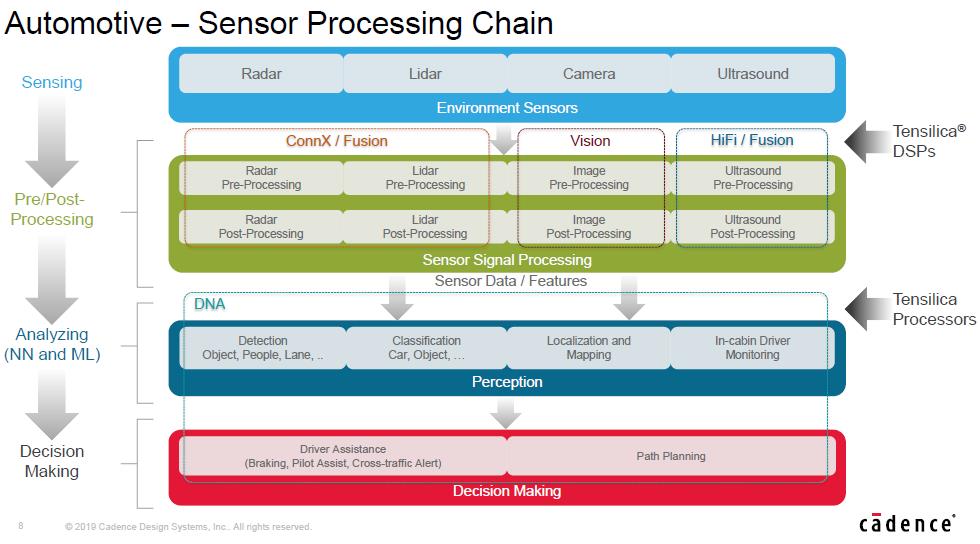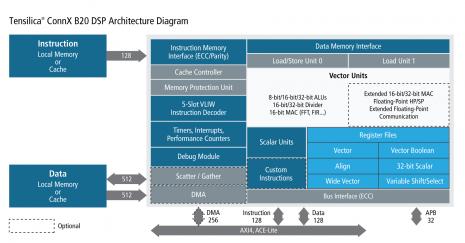To replace a human driver, autonomous car will have to “see” and do it in a better way than human being. The available solution, based on camera, radar, lidar, is not perfect and need to be improved. Radar is great for “seeing” in bad weather but has insufficient resolution to distinguish distant objects. Lidar produces high-resolution images but is unreliable in bad weather. A combination of two could be attractive, unfortunately the lidar cost (in the several $1K range!) is way too expensive to deploy the technology in autonomous driving to have a chance to penetrate the broad automotive market.
Engineers are working hard to propose drastic cost reduction and shrink for lidar and to develop higher resolution radar. Using solid-state and MEMS technology in lidar will help lower cost and reduce size, while radar is moving toward higher resolution “imaging” radar through more antennas and 4D.

The Cadence/Tensilica DSP based solution, is able to run lidar sensor pre-processing and processing in order to provide sensor data to be analyzed through neural network and machine learning included in the DNA processor family, and finally decision to support driver assistance.
This “philosophy” should allow to develop more affordable lidar and most efficient radar in the future and help democratize autonomous car. Cadence/Tensilica offers a broad range of Application-Specific DSPs supporting radar, lidar, 5G, 4G/LTE-A, bluetooth, smartgrid, and 802.11 modems. Based on a deeper processor pipeline architecture, the ConnX B20 DSP provides a faster and more power-efficient solution for the automotive and 5G communications markets—including next-generation radar, lidar, V2X, UE/infrastructure and IoT applications.
There are three main sensors required going forward: cameras, radar and lidar. Cameras use visible light and rely on any objects they wish to see being illuminated. Radar and Lidar sensors emit (modulated) electromagnetic waves that reflect off objects and are then detected back at the sensor. The “R” in Radar is for Radio, the “L” in Lidar is for Light.
Radar sensors emit millimeter waves that work well in poor weather conditions and at long distances as the waves are not easily attenuated in the atmosphere. However, although they are small and low cost, today they are not able to produce a high-resolution image at a distance that can distinguish between multiple objects – something that lowers the safe speed for AD if relied upon for object detection. Radar manufacturers are now developing “imaging” or ”4D” radar solutions that provide much higher resolution from the use of more antennas and much more digital signal processing.
Lidar sensors emit nanometer waves (laser beams) and is a surveying method that measures distance to a target by illuminating the target with pulsed laser light and measuring the reflected pulses with a sensor. Differences in laser return times and wavelengths can then be used to make digital 3-D representations of the target.
Imaging lidar can be performed using arrays of high-speed detectors and modulation sensitive detector arrays typically built on single CMOS chips. In these devices each pixel performs some local processing such as demodulation or gating at high speed, down-converting the signals to video rate so that the array can be read like a camera. Using this technique many thousands of pixels / channels may be acquired simultaneously. High resolution 3-D lidar cameras use homodyne detection with an electronic CCD or CMOS shutter.
In 2014, Lincoln Laboratory announced a new imaging chip with more than 16,384 pixels, each able to image a single photon, enabling them to capture a wide area in a single image. The chip uses indium gallium arsenide (InGaAs), which operates in the infrared spectrum at a relatively long wavelength that allows for higher power and longer ranges. In many applications, such as self-driving cars, the new system will lower costs by not requiring a mechanical component to aim the chip.
In conclusion, when the industry will be able to get rid of electro- mechanical component and move to CMOS MEMS devices, it will be possible to broadly integrate Lidar technology in the automotive industry. Benefiting from high performance DSP IP will also be key to enable low cost processing to support Lidar, that’s the goal of Cadence/Tensilica ConnX B20DSP!

Tensilica/Cadence ConnX B20DSP has been designed to provide significant improvements compared to the ConnX BBE32EP DSP. The B20 DSP is up to 30X faster in parts of the communication processing chain and up to 10X faster in parts of the radar/lidar processing chain.
With deeper processor pipeline, B20DSP offers higher frequency, 1.4 GHz or greater in 16nm. The instruction-set has been enhanced and for higher accuracy, offers more floating point and forward error correction (FEC). Tensilica existing customers will enjoy software compatibility with other members of the ConnX DSP family, and new customers should enjoy easy scalability for product roadmaps and across product lines!
Readers can get more information:
https://ip.cadence.com/ipportfolio/tensilica-ip/comms-dsp&CMP=TIP_CnXB20_IndTre_Arti_0219_PP
ByEric Esteve fromIPnest
Share this post via:




Comments
There are no comments yet.
You must register or log in to view/post comments.